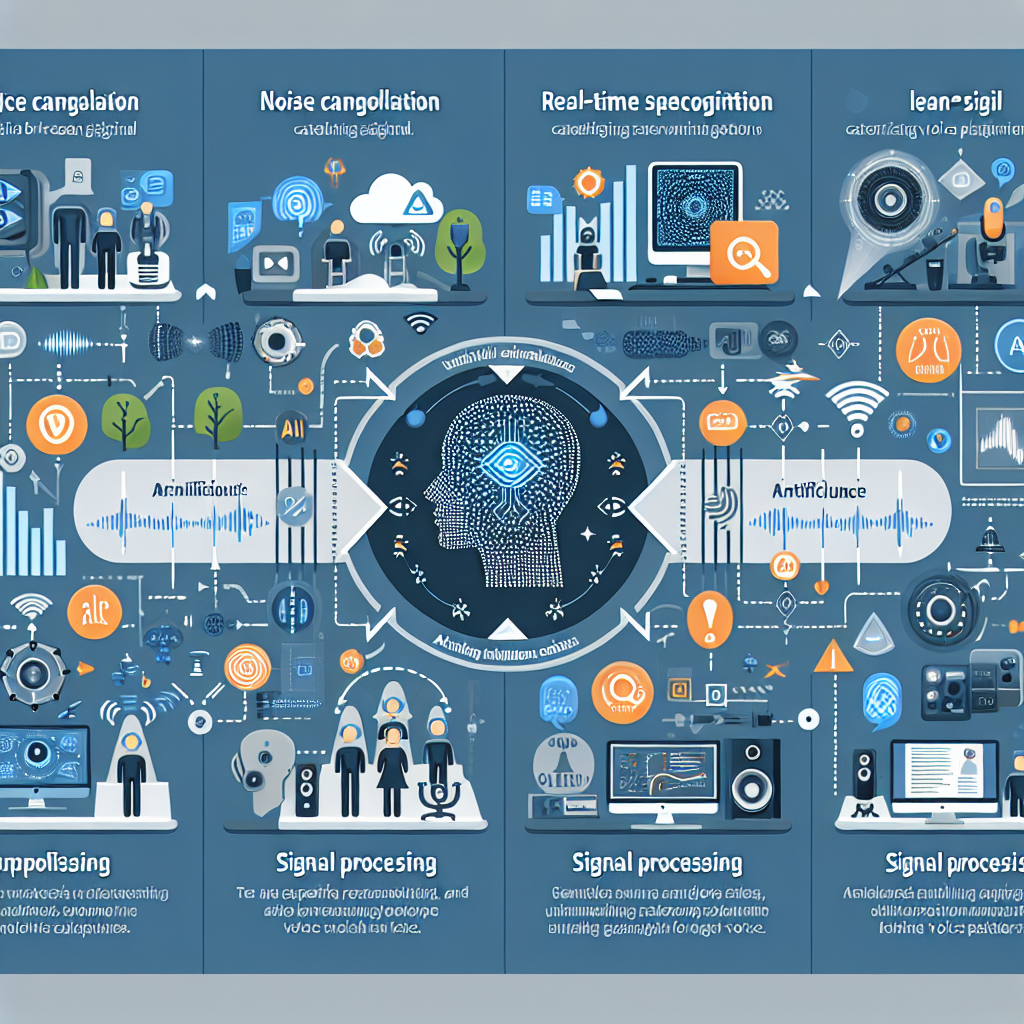
In the digital era we're living in, it's virtually impossible to ignore the significant impact of technology on our everyday communications. More specifically, the intersection between artificial intelligence (AI) and voice communication presents an exciting frontier that holds the promise of revolutionizing the way we communicate, especially when it comes to the issue of voice clarity during calls with poor connections. AI-enhanced voice clarity is not just a buzzword; it's a combination of machine learning solutions that strive to improve the call quality in real-time, even under the worst connection conditions.

Have you ever been on a call where the other person's voice incessantly breaks, or the audio quality is so degraded that you can hardly understand what's being said? It's frustrating, isn't it? Luckily, experts in the field of AI and machine learning are leveraging these technologies to address these challenges. The goal is to create a tech ecosystem where the call quality is consistently excellent, irrespective of the network signal strength or bandwidth constraints. The solution lies in using AI algorithms to denoise, dereverb, or even remove echo from the voice signals in real-time, thus delivering clear and crisp audio. This contributes to effective communication and the user's overall satisfaction.
The advances in this promising technology, thankfully, are not in the distant future — they're happening right now. By using machine learning algorithms that adapt to different types of distortions in voice signals, AI can enhance voice clarity and significantly reduce frustrating call dropouts or voice quality issues. And the best part? These AI solutions are increasingly becoming more accessible and affordable, making them a viable option for businesses and individuals all over the world.
Throughout this article, we will delve into the nuts and bolts of how precisely AI-enhanced voice clarity works, and the key pillars that make it an essential asset in improving call quality during poor network conditions. And since it's a rapidly growing field, we'll also shed light on the latest trends and future perspectives which underline its immense potential in shaping the telecommunications landscape of tomorrow.
In the age of seamless communication, experiencing issues during voice calls can be incredibly frustrating. Amidst the spectrum of technologies that facilitate voice communication, there exist numerous factors that contribute to declined call quality. These can especially pose challenges for individuals residing in remote or poorly connected areas. This section will elaborate on the common problems encountered: latency, packet loss, and fluctuating bandwidth.
Latency, commonly known as lag, refers to the delay experienced in the transmission of voice data. This can lead to confusion, overlapping conversation, or even result in parts of the conversation getting cut off, compromising the quality and effectiveness of the communication. Latency can be mostly attributed to the geographical distance the data needs to travel, however, substandard equipment and poor connectivity also play a role. Click here for a comprehensive understanding of latency.
Another obstacle is packet loss. When voice data is transferred over the network, it is divided into numerous packets. Packet loss occurs when these individual packets fail to reach their destined recipient, leading to disrupted, unclear, or incomplete audio. This phenomenon is often the result of network congestion, inadequate bandwidth, or faulty hardware. Learn more about packet loss and its potential solutions through this link.
Finally, fluctuating bandwidth significantly impacts call quality. Bandwidth pertains to the maximum rate of data transfer across a given path. When several applications or devices are using the network simultaneously, the bandwidth can fluctuate, thus impinging upon the delivery of voice data. This leads to diminished audio quality, causing the voice to break or become muffled. The concept of bandwidth and factors affecting it are more thoroughly explained here.
In conclusion, factors such as latency, packet loss, and fluctuating bandwidth remain challenges in traditional voice communication, often exacerbated in remote or poorly connected areas. However, advancements in technology like Artificial Intelligence (AI) promise enhanced voice clarity, paving the way for improved call quality irrespective of geographical barriers or poor connections.
In today's digitally connected world, the need for top-notch audio quality in calls cannot be overstated. Poor call quality results in frustrating communication experiences, often causing lapses in understanding and productivity. Fortunately, with the advent of Artificial Intelligence (AI), poor connection is no longer a barrier to voice clarity. AI-enhanced voice clarity is a technological breakthrough that ensures clear, uninterrupted communication irrespective of connection quality.
This remarkable improvement is chiefly attributed to three key technologies: noise cancellation algorithms, real-time speech recognition, signal processing. Here's how these work in concert to enhance voice clarity:

Firstly, AI-powered noise cancellation algorithms are able to discern, in real-time, background noise from a speaker’s voice. By distinguishing these two, AI can effectively remove unwanted noise, enabling the listener to hear only the speaker’s voice. Tools like Krisp harness the power of deep learning for this purpose, delivering clear audio irrespective of surrounding noise.
Secondly, real-time speech recognition is an AI technique used to identify and understand spoken language rapidly. Algorithms like Google’s Cloud Speech-to-Text can transcribe audio to text in real time, thereby assisting those with hearing constraints and mitigating issues in cross-language communication.
Lastly, signal processing comes into play. Signal processing techniques analyze and alter voice signals to improve overall voice quality. Alterations typically include the amplification of the speaker's voice and the equalization of audio frequencies to produce a more balanced sound.
In summary, AI-enhanced voice clarity is transforming call quality, making communication easier and more enjoyable. With ongoing advancements in AI, we look forward to even more incredibly innovative solutions in near future.
In the evolving world of digital communication, AI-enhanced voice clarity reigns as a groundbreaking approach for improving call quality, even in poor connection scenarios. These innovative solutions have empowered businesses and individuals alike, enabling improved communication and better satisfaction rates overall.
AI-enhanced voice clarity tools apply sophisticated machine learning algorithms and signal processing techniques to boost the quality of online calls. These tools effectively reduce noise, enhance clarity, and provide consistent call quality irrespective of network conditions.
These improvements contribute to substantial reductions in call abandonment, which is a frequent phenomenon in poor network conditions. By ensuring clearer communication, AI-enabled voice clarity systems prevent critical miscommunications and foster confidence in digital interactions. Therefore, these tools prove indispensable in maintaining top-tier customer service in challenging contexts.
Moreover, the advanced signal processing techniques employed by AI systems promote a better audio experience, ensuring high satisfaction rates. With clearer audio, professional meetings, webinars, or casual calls are noticeably better, as participants can concentrate on the content instead of straining to understand disturbed or unclear audio. Using AI for Good: For Better Audio Quality In Conference Calls offers an intriguing perspective about this transition to an AI-based solution.
In conclusion, AI-Enhanced Voice Communication serves as a vital tool for effective, clear communication, which is a key organizational best practice. By championing the balance between human interactions and AI enhancements, call quality can be augmented to unprecedented levels, unlocking new potentials in the realm of digital communication.
As infrastructure continues to improve worldwide, not every place, or every connection, has access to high-quality internet or voice communication. In this case, AI-Enhanced Voice Clarity technologies are proving to be game-changers. From finance to telecommunications and healthcare, numerous sectors are harnessing these advancements to ensure smooth and efficient operations.

The application of AI Voice Clarity in the financial sector offers a compelling case study. In banking and finance, clear call quality is paramount for customer service. Given the global nature of these industries, connecting disparate regions with potentially subpar network connectivity is a constant challenge. VoiceSense, an AI-driven predictive speech analytics company, has been using its technology to improve voice clarity and quality during customer service interactions. By doing this, they've increased customer satisfaction and improved the overall communication efficiency within the sector.
Similarly, in the healthcare industry, telemedicine has become integral, more so during the COVID-19 pandemic. Voca.ai, an AI startup focusing on conversational AI, enhanced the readability of dialects and regional accents to improve patients' understanding, despite poor connections. This resulted in more effective consultations and improved patient outcomes.
Lastly, the telecommunications industry, where the technology is most relevant, has seen substantial improvements in service quality owing to AI Voice Clarity tools. For instance, TOMIA, a major provider of connectivity solutions, has used AI to improve High Definition voice clarity which heightened the quality of international calls and allowed for seamless business transactions, particulary in areas with questionable signal strength.
These real-world applications of AI-Enhanced Voice Clarity demonstrate not only the adaptability of AI technologies but also their capacity to enhance communication across various sectors, even in places with poorer connections.
In the constellation of communications technology, AI-enhanced voice clarity shines brightly as one of the most impactful innovations of recent years. Its influence on call quality, particularly in environments with poor connections, is undeniably profound. By leveraging artificial intelligence, voice calls are clarified and clarified regardless of external conditions, effectively bridging the gap between parties. This breakthrough largely negates the notorious 'poor connection' problem, significantly improving the efficiency and effectiveness of communication.
In predictive market analyses, projections are optimistic regarding the role of AI in enhancing voice clarity even further. Future applications not only promise even clearer voice communications but also anticipate advancements in noise cancellation technologies and voice recognition capacities. These improvements will undoubtedly impact various sectors, from teleconferencing and customer service to emergency response systems.
Building on current achievements, the trajectory of AI-enhanced voice clarity launches into a future where digital communication evolves into a more seamless and intuitive experience. In envisioning this future, we find ourselves moving towards a world where poor connectivity hitches and unintelligible audio are relics of a bygone era. This is not just a technical achievement; it's a timely response to a world increasingly reliant on digital communication.
Looking ahead, it is clear that the intersection of AI and voice technology harbours immense potential. As the field expands, so too does our potential to foster connections and facilitate communication on a global scale. Our calls will get clearer, our meetings will become more productive, and we will get one step closer to true communication without barriers.
From its promising beginnings, AI-enhanced voice clarity has rapidly grown into an invaluable tool. Time will undoubtedly unveil more of its untapped potential, influencing not only how we connect and converse but also how we navigate an increasingly digital world.
Start your free trial for My AI Front Desk today, it takes minutes to setup!








